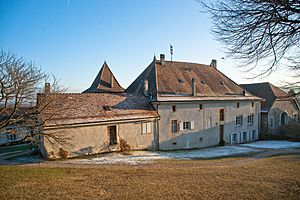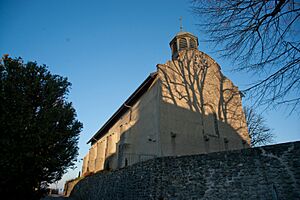Pampigny facts for kids
Quick facts for kids
Pampigny
|
||
|---|---|---|

Pampigny village
|
||
|
||
| Country | Switzerland | |
| Canton | Vaud | |
| District | Morges | |
| Area | ||
| • Total | 11.09 km2 (4.28 sq mi) | |
| Elevation | 650 m (2,130 ft) | |
| Population
(2003)
|
||
| • Total | 849 | |
| • Density | 76.56/km2 (198.28/sq mi) | |
| Postal code |
1142
|
|
| Surrounded by | Apples, Chavannes-le-Veyron, Cottens, Grancy, L'Isle, Mauraz, Mollens, Montricher, Sévery | |
Pampigny used to be a town, or 'municipality,' in Switzerland. It was located in the Morges area, within the Vaud region. On July 1, 2021, Pampigny joined with several other towns like Apples and Cottens. They all became part of a new, bigger town called Hautemorges.
Contents
History of Pampigny
Pampigny was first written about in the year 1141. Back then, its name was 'Pampiniaco'.
Geography and Landscape
Pampigny covers an area of about 11 square kilometers (4.3 square miles). A large part of this land, about 57.7%, is used for farming. Forests cover another big section, about 36.5% of the area.
About 5% of the land has buildings or roads. A very small part, 0.1%, is made up of rivers or lakes. The rest, about 0.6%, is land that cannot be used for farming or building.
Most of the forested land is covered with thick forests. For farming, nearly half of the land is used for growing crops. The rest is used as pastures for animals. All the water in the area is found in lakes.
Pampigny is located at the bottom of the Jura Mountains. Until 2006, it was part of the Cossonay District. After that, it became part of the new Morges District.
Pampigny's Coat of Arms
The coat of arms for Pampigny has a special design. It shows two silver crosses shaped like an 'X' on a red background. These crosses are surrounded by four golden acorns.
Population and People
In 2019, Pampigny had a population of 1,103 people. Over the past 10 years, the number of people living there grew by about 20.6%. Most of this growth was from people moving into the town.
Most people in Pampigny speak French, about 92.4% of the population. German is the second most common language, spoken by 4% of the people. A smaller number of people, about 1.4%, speak English.
In 2000, about 32.5% of the people living in Pampigny were born there. Another 36.1% were born in the same region, or canton. About 18.6% were born elsewhere in Switzerland. The remaining 11.6% were born outside of Switzerland.
The age groups in Pampigny in 2009 showed that 11.9% of the population were children aged 0-9. Teenagers, aged 10-19, made up 15.5%. Adults aged 20-59 made up about 57.5% of the population. Older adults, aged 60 and above, made up about 15.1% of the population.
Important Buildings and Sites
The entire village of Pampigny is recognized as an important heritage site in Switzerland. This means it has historical or cultural value that needs to be protected.
Economy and Jobs
In 2010, the unemployment rate in Pampigny was 3.8%. This means a small percentage of people who wanted to work could not find a job.
In 2008, many people worked in different types of jobs:
- Primary Sector: 60 people worked in this sector, which includes farming and forestry. There were 23 businesses in this area.
- Secondary Sector: 51 people worked in this sector, which includes manufacturing and construction. There were 11 businesses here.
- Tertiary Sector: 75 people worked in this sector, which includes services like sales, transportation, hotels, and education. There were 24 businesses in this area.
Overall, 388 residents of Pampigny had jobs. About 43.3% of these workers were women.
Many people who lived in Pampigny traveled to other towns for work. In 2000, about 259 people left Pampigny for their jobs, while only 64 people came into Pampigny to work. Most people, about 66.8%, used a private car to get to work. About 6.7% used public transportation.
Religion in Pampigny
Based on information from 2000, most people in Pampigny belonged to Christian churches. About 58% were part of the Swiss Reformed Church. Another 17.5% were Roman Catholic.
A smaller number of people belonged to other Christian churches. There were also a few people who were Jewish or Islamic. About 14.86% of the population did not belong to any church.
Education and Schools
Many people in Pampigny have completed a good level of education. In 2000, about 32.6% of the population had finished high school. About 15.2% had gone on to higher education, like a university.
In the 2009/2010 school year, there were 157 students in the Pampigny school district. The local school system provides two years of optional pre-school. The primary school program lasts for four years, and there were 78 students in primary school. The middle school program lasts for six years, with 75 students attending.
Some students from Pampigny, about 144, went to schools outside the town. At the same time, 35 students from other towns came to school in Pampigny.
Images for kids
See also
 In Spanish: Pampigny para niños
In Spanish: Pampigny para niños







